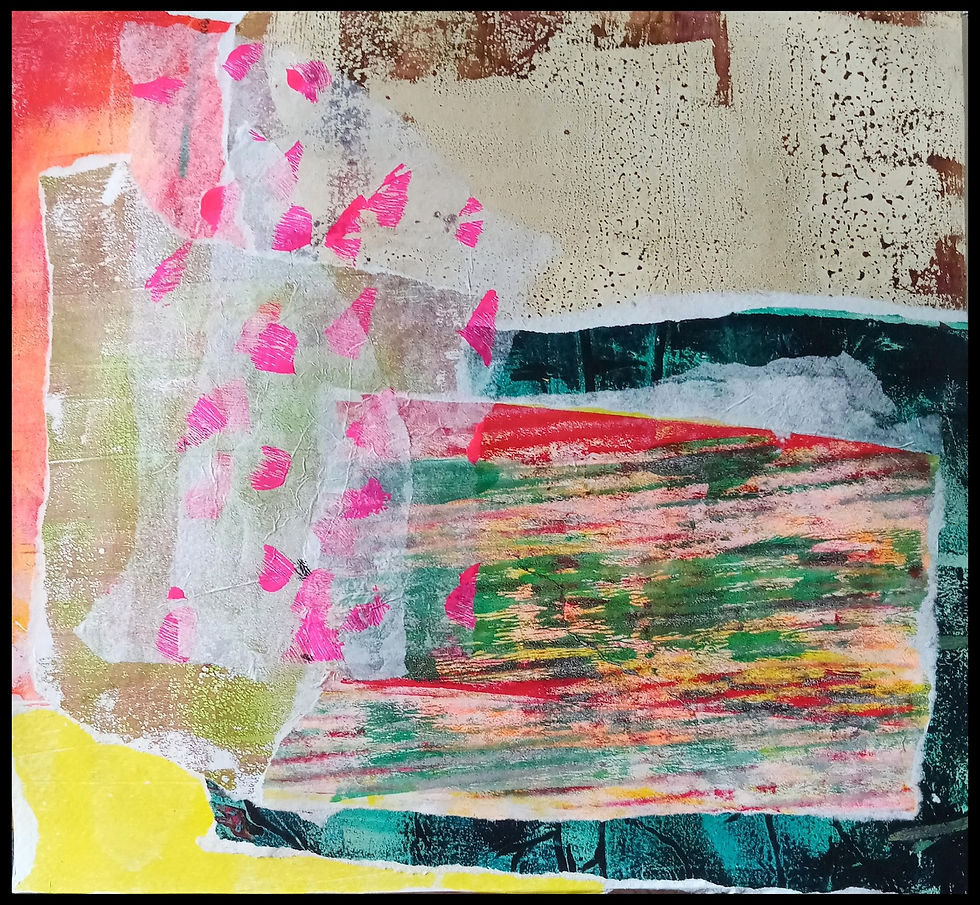Finding Liberation Through Layers
- Confluence Community
- Sep 11
- 3 min read

Finding Liberation Through Layers
Amanda Flores is an American abstract artist whose work lives in the in-between spaces: between identity and liberation, design and intuition, structure and play. Using mixed media, collage, and assemblage, Amanda creates pieces that are as layered as the stories behind them. Each work is a personal reflection and an invitation for others to find connection in the fragments, colors, and textures she pieces together.
Amanda is a disabled, neurodivergent woman who has navigated the complexity of identity and independence through art. Her journey into making was not a gradual pursuit but a sudden necessity, faced with profound personal challenges and a sense of isolation. Amanda turned to art as a coping mechanism, a way of recalibrating her focus, her energy, and ultimately, her life.
“I logged off all social media for many months,” Amanda recalls. “In those months, I recalibrated how I generated dopamine, from the instantaneous hit of short-form video and ‘likes’ to the slow burn of learning how to draw portraits with the Loomis method. I felt like I could finally focus on something for more than 20 seconds and get a deep sense of reward from it. And thus began my deep dive into everything art: art history, color theory, art movements, design and composition.”
This deep dive led Amanda to explore portraiture and collage and to embrace the power of art history and modernist design. Inspired by artists like Paul Klee, Josef Albers, and the Bauhaus movement, Amanda incorporates elements of classical design alongside intuitive practices, pieces that hold both discipline and play in tension.
Her current series, “Home Again,” is especially personal. Born of life transitions that brought her back to her childhood home, the work reflects the layered environment of returning to a place infused with memory, responsibility, and self-discovery.
“It’s where I simultaneously coexist with my very precocious inner child as a wife, as a daughter, as a caretaker, and as a woman in America, unmasked and disabled,” Amanda shares. “I want to capture these experiences and extrapolate a narrative about what this identity means in my current time and place.”

Collage as a Healing Practice
For Amanda, collage is more than a technique; it is a practice of healing. She often uses acrylic-painted paper, mounted on wooden substrates, alongside salvaged and secondhand materials. These fragments, once discarded, are reassembled into something whole, a metaphor for resilience, for piecing together the fragments of identity, memory, and experience into something liberating.
Her work is not about aesthetics, but about survival, connection, and the reclamation of joy. Through collage, Amanda has found a way to translate personal struggle into collective language. “Art feels like I’m communicating in this completely visual, ancestral language that I’ve known innately my whole life,” she says. “And I’m connected to every other artist who has lived and will live.”

Community and Connection
Amanda is also invested in the role of art as a communal practice. She is launching a collage club in her hometown of Sebring, Florida, a space where others can gather, create, and connect through art. In her eyes, these small, grassroots communities are where art finds its truest purpose: as a bridge between people and as a way to remind us that “life is beautiful and our subjects are precious.”
As our September 2025 Artist of the Month, Amanda reminds us that art is more than exhibitions and accolades. It is a coping mechanism, a means of processing, and a tool for building identity and community.
Her work asks us to pause and consider: what do we do with the fragments of our own lives? How do we assemble the pieces of memory, challenge, and hope into something that feels whole?
Are you interested in joining our Artist of the Month Program? Applications for 2026 are open now!
Virtual Gallery, Bio, and a Mini-Zine Coming Soon!
.png)








Comments